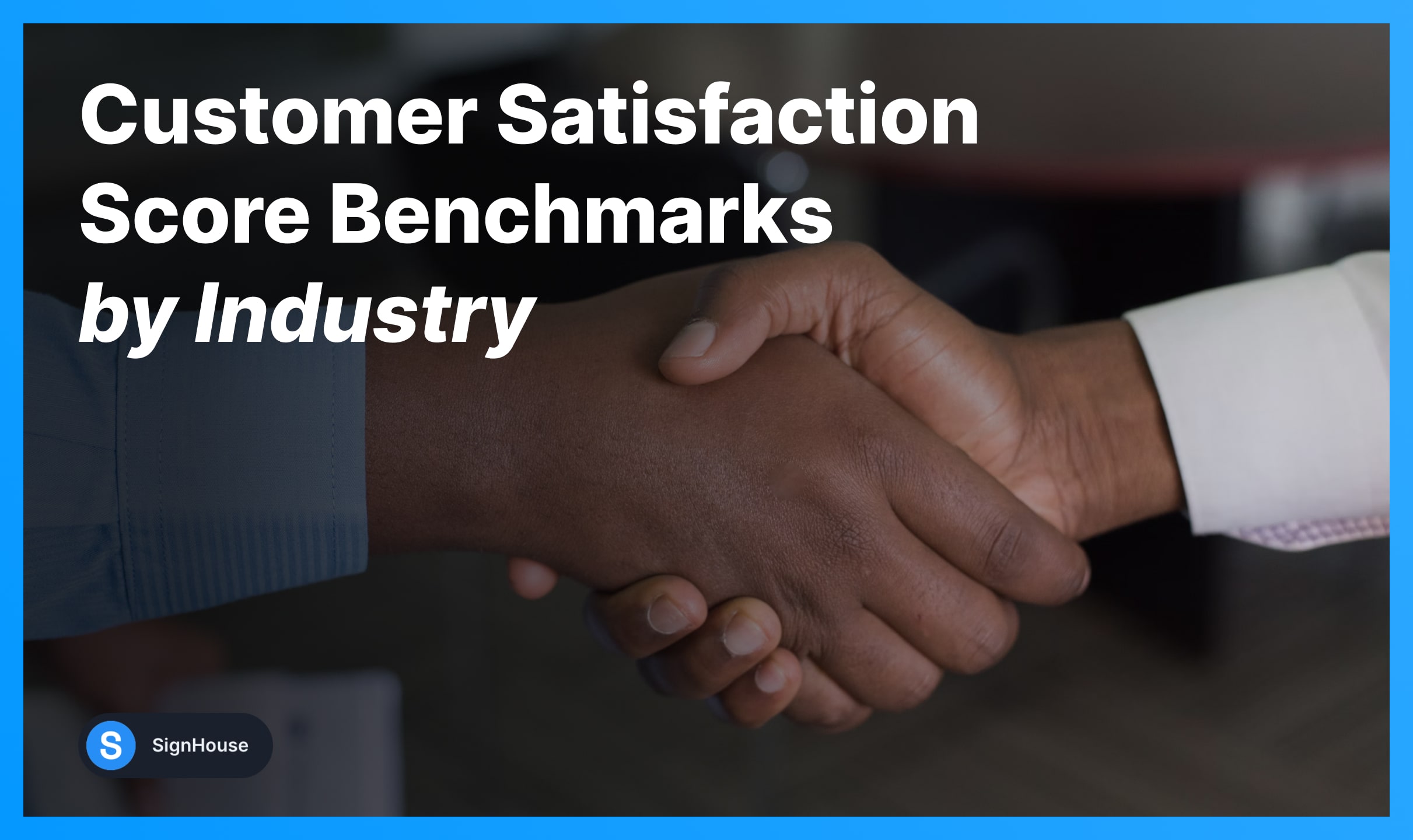Customer Satisfaction Score Benchmarks by Industry

According to Mckinsey, satisfied customers are more likely to upgrade and are least likely to switch to another company. Over 33% of Americans say that they will switch a company after a bad customer service experience.
You don’t want your customers to switch, right?
The easiest methodologies to measure customer satisfaction are Customer Satisfaction Score (CSAT) and Net Promoter Score (NPS).
What makes CSAT and NPS so special?
Both these customer satisfaction techniques are easy-to-administer, contain a single question, easy-to-commute, and have a lot of benchmark reports available for comparison. The customer satisfaction score benchmarks make it extremely easy to compare your scores against the industry average.
CSAT Benchmark Scores by Industry
Customer Satisfaction Score (CSAT) offers you a simple way to measure customer satisfaction at any given point. You can measure satisfaction related to any product and interaction. It consists of a single question that directly asks the satisfaction level of customers with their experience.
Customers rate their satisfaction based on their experience.
Here are a few features that make CSAT the best satisfaction methodology:
- CSAT is simple
- It works for all types of buyers and throughout the customer lifecycle journey
- It focuses on individual customer satisfaction
- Computing CSAT doesn’t require a lot of hard work
- It yields a high response rate as customers only have to answer one simple question.
CSAT is measured in percentage. A higher percentage is preferable as it suggests that a high percentage of customers are satisfied. Customer satisfaction score benchmarks help you find industry average percentage for CSAT score.
Customer satisfaction score benchmarks 2020
This lets you compare your score with the industry benchmarks. You can see how well you’re doing as compared to other businesses. The American Customer Satisfaction Index (ACSI) releases the CSAT benchmark report every year. Below are the benchmarks by industry for 2019:
- Breweries – 84%
- Personal Care and Cleaning Products – 83%
- Televisions and Video Players – 82%
- Food Manufacturing – 82%
- Soft Drinks – 82%
- Internet Investment Services – 81%
- Full-Service Restaurants – 81%
- Household Appliances – 81%
- Banks – 80%
- Life Insurance – 80%
- Credit Unions – 79%
- Athletic Shoes – 79%
- Automobiles and Light Vehicles – 79%
- Property and Casualty Insurance – 79%
- Limited-Service Restaurants- 79%
- Internet Travel Services – 79%
- Financial Advisors – 79%
- Cellular Telephones – 79%
- Personal Computers – 78%
- Consumer Shipping – 78%
- Computer Software – 78%
- Apparel – 77%
- Internet News and Opinion – 77%
- Internet Search Engines and Information – 77%
- Ambulatory Care – 77%
- Video Streaming Service – 76%
- Cooperative Energy Utilities – 75%
- Wireless Telephone Service – 75%
- Hotels – 75%
- Airlines – 74%
- Health Insurance – 74%
- Investor-Owned Energy Utilities – 73%
- Municipal Energy Utilities – 73%
- Internet Social Media – 72%
- Hospitals – 72%
- Fixed-Line Telephone Service – 71%
- U.S. Postal Service – 70%
- Video-on-Demand Service – 67%
- Internet Service Providers – 62%
- Subscription Television Service – 62%
Let’s assume you’re in the soft drinks industry and your CSAT score turns out to be 71%. The industry benchmark is 82% which means you’re not doing a decent job. You need to work on customer satisfaction.
You need to focus on improving customer satisfaction so your average score equals or exceeds the industry benchmark.
NPS Benchmark Scores by Industry
Net Promoter Score is a simple and effective technique for measuring customer satisfaction. It asks a single question from the respondents that goes something like this:
“How likely are you to recommend [our company] to a friend or colleague?”
The customers rate their responses on a scale between 0 and 10. A high score is preferable as it means that customers are more likely to recommend your business to a colleague or friend.
The customers are categorized as detractors, passives, and promoters.
The NPS percentage is calculated by subtracting the total percentage of detractors from the total percentage of promoters. The resultant is your Net Promoter Score.
You need to compare the NPS score with industry benchmark scores to make sense of it. If your NPS is 52, it’s hard to figure out if it is good or bad. This is where relevant customer satisfaction score benchmarks become handy. You can compare your score with industry benchmarks and see how well you’re doing.
NICE Satmetrix publishes B2C and B2B Net Promoter Score benchmark reports each year. Here is an overview of the B2C industry benchmarks for 2019:
- Department/specialty stores – 52
- Tablet computers – 51
- Brokerage/investment – 46
- Online entertainment – 43
- Online shopping – 43
- Airlines – 39
- Auto insurance – 39
- Credit cards – 37
- Laptop computers – 36
- Hotels – 36
- Home insurance – 35
- Smartphones – 34
- Banking – 34
- Grocery/supermarkets – 32
- Cellphone service – 32
- Software and apps – 30
- Shipping services – 28
- Life insurance – 26
- Drug stores/pharmacies – 26
- Travel websites – 18
- Health insurance – 14
- Cable/satellite TV – -6
- Internet service – -7
You can see that the benchmarks by industry vary greatly. Not comparing your score against benchmarks won’t help you much as you won’t be able to use your NPS results for decision-making.
You can also use NPS benchmarks by Delighted. They have a tool that lets you compare your NPS with your preferred industry.
It shows you low, average, and high NPS in your industry as well as top companies in your industry. This makes comparison easy yet meaningful.
Additionally, Delighted has listed NPS benchmarks for 20 industries. It includes the low, average, and high NPS for each industry. For instance, the software industry has 28, 41, and 55 NPS where 28 is low, 41 is average, and 55 is high.
What NPS benchmarks you should use?
I’d recommend using both. Check your score with the Satmetrix industry benchmark report and then enter your score in the Delighted comparison tool for further insights. This will give you a better idea of what exactly your NPS means.
How to Improve Customer Satisfaction Score?
Finding customer satisfaction scores using any method isn’t rocket science. There are tons of tools that will automate the entire process for you. Comparing your score against customer satisfaction score benchmarks by industry isn’t any big deal either. You can find any benchmark report in your industry and do the comparison.
What’s challenging is improving customer satisfaction scores after the comparison. When your score is low than the average, this calls for improvement in customer experience and/or product or its features.
The real challenge is taking the right actions to improve customer satisfaction. This can be achieved by conducting interviews with customers, collecting feedback via surveys, and using best practices to offer your customers with the best experience and services that they expect.
If you’re not using customer satisfaction scores for decision-making, you’re wasting resources. Any data that you don’t use for improvement is useless.
Make sure you don’t make this mistake.








